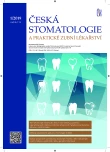Pharmacotherapy of recurrent aphthous stomatitis in patients with genetically impaired ability to metabolize folic acid – pilot study
Authors:
P. Bořilová Linhartová 1,2; A. Fassmann 1; J. Linhartová 1,3; L. Izakovičová Hollá 1,2
Authors‘ workplace:
Stomatologická klinika, Lékařská fakulta Masarykovy univerzity a Fakultní nemocnice u sv. Anny, Brno
1; Ústav patologické fyziologie, Lékařská fakulta Masarykovy univerzity, Brno
2; Lékárna Plumlov, s. r. o., Plumlov
3
Published in:
Česká stomatologie / Praktické zubní lékařství, ročník 119, 2019, 1, s. 4-11
Category:
Original articles
Overview
Introduction, aim: When treating recurrent aphthous stomatitis (RAS), a so-called Skach‘s therapy, in which patients are administered folic acid and vitamin B6, is recommended. The human body can process folic acid only in the form of active folate (vitamin B9); methylenetetrahydrofolate reductase (MTHFR) plays an important role in metabolic transformation, function of this enzyme is fundamentally influenced by gene polymorphisms. The aim of the study was to verify the assumption that administration of the active form of folic acid together with vitamins B6 and D3 can positively affect the frequency of aphthae/ulcers eruption and the course of their healing in patients with RAS.
Methods: In the pilot study, we clinically examined ten patients in whom we analyzed haplogenotypes in the MTHFR gene. Conditions for inclusion of patients with RAS were: age 18–50 years, Czech nationality, genetically impaired ability to metabolize folic acid (poor metaboliser – PM or intermediate – IM) and the absence of systemic disease (Crohn‘s disease, Behçet‘s disease, kidney disease and other diseases). Pharmacotherapy in a modified double-crossed blind study (cross-over design) ran from spring 2018 and lasted three months. Patients were treated with active folate (glucosamine salt 5-methylfolate), vitamins B6 and D3 in the three-phase regimen, they were not allowed to use any other food supplements during the therapy. They kept daily records of their health status and possible risk factors for RAS and were examined clinically and in the laboratory at monthly intervals.We recorded both the subjective evaluation of the effect of the therapy by patients and the obtained laboratory
data, which were evaluated by statistical software Statistica v.13.
Results: The study was comprised of three men and seven women with RAS, aged 28 to 47 years; according to the MTHFR gene profile, three were defined as PM and seven as IM of folic acid. Based on the subjective assessment, one patient reported a deterioration, two patients did not observe a change in their health state during therapy, and seven were satisfied because they had a lower or no aphthae eruption and/or healing time was significantly shorter. Subjective evaluation of therapy positively correlated with objective clinical finding (r = 0.993, P < 0.001). The laboratory analysis showed that administration of vitamin D3 significantly increased serum concentrations of 25-OH D3 from low/limit to optimal values, median of concentrations prior to study was 54.2 nmoll-1, just before administration 68.1 nmoll-1 vs. month after administration 96.6 nmoll-1 (norm: 50–175 nmoll-1), (P ≤ 0.01). The other studied parameters, such as concentration of folic acid in serum, homocysteine, ALT, AST, and blood count, were within the physiological range before and after therapy.
Conclusion: The proposed modification of Skach‘s vitamin therapy seems to be appropriate for the treatment of patients suffering from RAS with genetic predisposition for reduced MTHFR function as during our observation, 70% of patients experienced subjective and objective improvement of their state.
Keywords:
oral mucosa disease – Pharmacogenetics – Metabolism – Folic acid
Sources
1. Slezák R, Kopecký O, Krejsek J.Recidivující afty. 1. vydání. Praha: Galén; 2000.
2. Bořilová Linhartová P, Valová S, Izakovičová Hollá L.Vrozená náchylnost k recidivující aftózní stomatitidě. Čes Stomat. 2017; 117(2): 27–34.
3. Škach M, Švejda J, Liška K. Onemocnění ústní sliznice: patologie, terapie a diferenční diagnostika onemocnění ústní sliznice. 1. vydání, Praha: Avicenum; 1975.
4. van der Put NM, Gabreëls F,Stevens EM, Smeitink JA, Trijbels FJ, Eskes TK, van den Heuvel LP, Blom HJ.A second common mutation in the methylenetetrahydrofolate reductase gene: an additional risk factor for neural-tube defects? Am J Hum Genet. 1998; 62(5): 1044–1051.
5. Weisberg I, Tran P, Christensen B, Sibani S, Rozen R.A second genetic polymorphism in methylenetetrahydrofolate reductase (MTHFR) associated with decreased enzyme activity. Mol Genet Metab. 1998; 64(3): 169–172.
6. Ślebioda Z, Szponar E, Dorocka-Bobkowska B.Vitamin D and its relevance in the etiopathogenesis of oral cavity diseases. Arch Immunol Ther Exp (Warsz). 2016; 64(5): 385–397.
7. Anand A, Singh S, Sonkar AA, Husain N, Singh KR, Singh S, Kushwaha JK.Expression of vitamin D receptor and vitamin D status in patients with oral neoplasms and effect of vitamin D supplementation on quality of life in advanced cancer treatment. Contemp Oncol (Pozn). 2017; 21(2): 145–151.
8. Jones P, Lucock M, Veysey M, Beckett E.The vitamin d-folate hypothesis as an evolutionary model for skin pigmentation: an update and integration of current ideas. Nutrients. 2018; 10(5): pii: E554. doi: 10.3390/nu10050554.
9. Branda RF, Eaton JW.Skin color and nutrient photolysis: an evolutionary hypothesis. Science. 1978; 201(4356): 625–626.
Labels
Maxillofacial surgery Orthodontics Dental medicineArticle was published in
Czech Dental Journal

2019 Issue 1
Most read in this issue
- Pharmacotherapy of recurrent aphthous stomatitis in patients with genetically impaired ability to metabolize folic acid – pilot study
- The occurrence of developmental enamel defects in very low and extremely low birth-weight infants
- Methods used for facial morphology research
